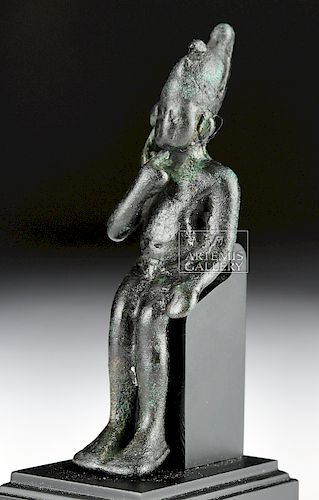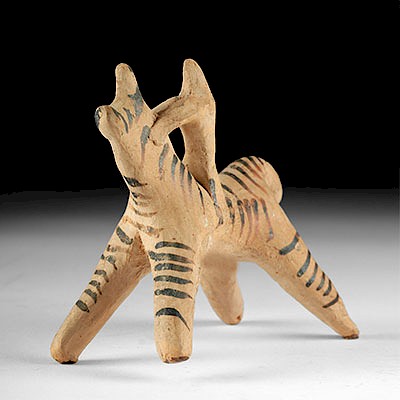Egyptian Bronze Figure - Seated Harpocrates
Lot 4
About Seller
Artemis Gallery
686 S Taylor Ave, Ste 106
Louisville, CO 80027
United States
Selling antiquities, ancient and ethnographic art online since 1993, Artemis Gallery specializes in Classical Antiquities (Egyptian, Greek, Roman, Near Eastern), Asian, Pre-Columbian, African / Tribal / Oceanographic art. Our extensive inventory includes pottery, stone, metal, wood, glass and textil...Read more
Estimate:
$2,000 - $3,000
Absentee vs Live bid
Two ways to bid:
- Leave a max absentee bid and the platform will bid on your behalf up to your maximum bid during the live auction.
- Bid live during the auction and your bids will be submitted real-time to the auctioneer.
Bid Increments
| Price | Bid Increment |
|---|---|
| $0 | $25 |
| $300 | $50 |
| $1,000 | $100 |
| $2,000 | $250 |
| $5,000 | $500 |
| $10,000 | $1,000 |
| $20,000 | $2,500 |
| $50,000 | $5,000 |
| $100,000 | $10,000 |
| $200,000 | $20,000 |
About Auction
By Artemis Gallery
Oct 25, 2018
Set Reminder
2018-10-25 11:00:00
2018-10-25 11:00:00
America/New_York
Bidsquare
Bidsquare : Antiquities from Egypt, Greece, Italy, Asia
https://www.bidsquare.com/auctions/artemis-gallery/antiquities-from-egypt-greece-italy-asia-3538
Featuring Egyptian, Greek, Roman, Etruscan, Near Eastern, plus Asian art from Central and Far East. If you love the classics, this is the sale for you. Artemis Gallery info@artemisgallery.com
Featuring Egyptian, Greek, Roman, Etruscan, Near Eastern, plus Asian art from Central and Far East. If you love the classics, this is the sale for you. Artemis Gallery info@artemisgallery.com
- Lot Description
Egypt, Late Dynastic Period, 26th to 31st Dynasty, ca. 664 to 332 BCE. A cast-bronze figurine depicting the child god Harpokrates (from the Egyptian "Her-pa-khered," literally "Horus the child"). He sits nude with both legs bent in front of his thin body, his right index finger extended to his mouth and left arm held to his side. Though faded, his face displays almond-shaped eyes, a wide nose, perky ears, and a drooping, separately-cast sidelock of hair. He wears a tall double crown with a frontal uraeus, symbolizing his rule over the unified Upper and Lower Egypt. Lustrous espresso-hued patina envelops the figure, with scattered areas of verdant green and pale-russet patina adding a touch of color. Custom museum-quality display stand included. Size: 1" W x 3.2" H (2.5 cm x 8.1 cm); 4" H (10.2 cm) on included custom stand.
Harpokrates (also Harpocrates) was, in many ways, one of the most popular deities in the Egyptian pantheon for centuries on end. The offspring of Osiris and Isis, Harpokrates was originally thought to be a protective deity, warding dangerous magic and creatures away from the wielder of his effigy. His depiction as a child was a common sight in ancient Egypt as infantile gods were favored to their adult characterizations from roughly the Third Intermediate Period on into Greco-Roman times. Created mostly as temple votives, child gods were thought to have a higher concentration of power and influence, thus making for a stronger prayer request when left as an offering.
References to Harpokrates appeared in classical literature, including Pseudo-Hyginus, Fabulae 277 (Roman mythographer c. 2nd century CE) and of course Ovid's Metamorphoses as we see in the following passage, "She saw before her bed, or seemed to see as in a dream, great (Egyptian goddess) Isis with her train of holy deities. Upon her brow there stood the crescent moon-horns, garlanded with glittering heads of golden grain, and grace of royal dignity: and at her side . . . (Harpocrates) the god who holds his finger to his lips for silence's sake." (Ovid, Metamorphoses 9.688 ff - trans. Melville - Roman epic ca. 1st century BCE to 1st century CE).
For a stylistically-similar standing example, please see The Metropolitan Museum of Art, accession number 04.2.613: https://metmuseum.org/art/collection/search/558376
Provenance: private East Coast, USA collection
All items legal to buy/sell under U.S. Statute covering cultural patrimony Code 2600, CHAPTER 14, and are guaranteed to be as described or your money back.
A Certificate of Authenticity will accompany all winning bids.
We ship worldwide and handle all shipping in-house for your convenience.
#135355Small loss to sidelock of hair, uraeus, verso, and side of neck. Possible restoration to one ear. Surface wear and abrasions commensurate with age as expected, fading to finer details on face, hands, and feet, darkening to coloration, and light roughness across most surfaces. Light earthen deposits within recessed areas. Nice espresso-hued patina throughout, with scattered areas of green and russet patina as well.Condition
- Shipping Info
-
All shipping is handled in-house for your convenience. Your invoice from Artemis Gallery will include shipping calculation instructions. If in doubt, please inquire BEFORE bidding for estimated shipping costs for individual items.
-
- Buyer's Premium



 EUR
EUR CAD
CAD AUD
AUD GBP
GBP MXN
MXN HKD
HKD CNY
CNY MYR
MYR SEK
SEK SGD
SGD CHF
CHF THB
THB
















